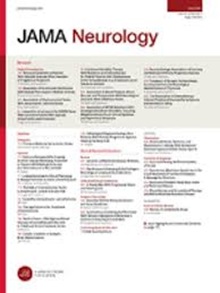Higher Educational Attainment and Accelerated Tau Accumulation in Alzheimer Disease.
IF 21.3
1区 医学
Q1 CLINICAL NEUROLOGY
引用次数: 0
Abstract
Importance The impact of educational attainment (EA) on longitudinal tau accumulation remains largely underexplored. Objective To investigate the association of EA with tau accumulation in Alzheimer disease (AD). Design, Setting, and Participants This cohort study used 3 independent samples: the Alzheimer's Disease Neuroimaging Initiative (ADNI; October 2015-July 2022, mean follow-up: 3.0 years), Anti-Amyloid Treatment in Asymptomatic Alzheimer's Disease study (A4; 2014-2022, mean follow-up: 4.7 years), and Greater-Bay-Area Healthy Aging Brain Study (GHABS; July 2021-August 2024, mean interval from plasma collection to tau positron emission tomography [PET]: 1.0 years). The ADNI and GHABS represent Northern American and Southern Chinese populations, respectively. A4 is a multicenter trial. Participants with amyloid β (Aβ) and subsequent tau PET were included from ADNI, A4, and GHABS, and a subset had plasma phosphorylated tau (p-tau) 217 (p-tau217) and resting-state functional magnetic resonance imaging (RS-fMRI) data. Data were analyzed from July 2022 to January 2025. Exposures EA, Aβ-PET, tau-PET, plasma p-tau217, and RS-fMRI. Main Outcomes and Measures Participants were classified as high EA and low EA based on median years of EA. Longitudinal tau changes were compared across Aβ-PET positivity and EA groups. Interactions of EA status with Aβ burden, entorhinal tau, and plasma p-tau217 on tau accumulation were investigated in Aβ-positive (Aβ+) individuals. Connectivity-associated tau spread was compared across different Aβ/EA groups. Whether or not Aβ-targeting treatment attenuated tau accumulation in Aβ+ high-EA individuals was also evaluated. Results This study included 887 participants: 377 from ADNI (mean [SD] age, 73.3 [7.2] years; 191 female [50.7%]), 395 from A4 (mean [SD] age, 71.9 [4.8] years; 223 female [56.5%]), and 115 from GHABS (mean [SD] years, 66.0 [7.4] years; 76 female [66.1%]). In the Aβ-negative group, high-EA individuals exhibited slower tau accumulation than low-EA individuals (right middle temporal gyrus: estimate = -0.002; 95% CI, -0.003 to -0.0002; P = .03). Conversely, higher EA in the Aβ+ group was correlated with accelerated tau accumulation (left middle temporal gyrus: estimate = 0.003; 95% CI, 0.0003-0.005; P = .03) and stronger Aβ-associated (left visual region: estimate = 0.38; 95% CI, 0.11-0.65; P = .006), entorhinal tau-associated (left middle temporal gyrus: estimate = 0.35; 95% CI, 0.08-0.63; P = .01), and plasma p-tau217-associated tau accumulation (left inferior temporal gyrus: estimate = 0.46; 95% CI, 0.02-0.90; P = .04), as well as increased connectivity-associated tau spread compared with lower EA (estimate = 0.33; 95% CI, 0.003-0.67; P = .048). Aβ-targeting treatment appeared to mitigate plasma p-tau217-associated tau accumulation in patients with AD and higher EA (estimate = -0.52; 95% CI, -0.80 to -0.24; P < .001). Conclusions and Relevance Results of this cohort study suggest that higher EA was associated with faster tau accumulation and spread in Aβ+ individuals, highlighting the importance of Aβ clearance in mitigating tau progression in patients with AD and higher EA.高等教育程度与阿尔茨海默病中Tau蛋白积累加速
教育程度(EA)对纵向tau积累的影响仍未得到充分研究。目的探讨EA与阿尔茨海默病(AD)中tau蛋白积累的关系。设计、环境和参与者本队列研究使用3个独立样本:阿尔茨海默病神经影像学倡议(ADNI);2015年10月- 2022年7月,平均随访时间:3.0年),抗淀粉样蛋白治疗在无症状阿尔茨海默病研究(A4;2014-2022年,平均随访4.7年),以及大湾区健康衰老脑研究(GHABS;2021年7月- 2024年8月,从等离子体采集到tau正电子发射断层扫描[PET]的平均间隔时间:1.0年)。ADNI和GHABS分别代表北美和中国南方的人口。A4是一项多中心试验。患有β淀粉样蛋白(a β)和随后的tau PET的参与者来自ADNI, A4和GHABS,其中一部分具有血浆磷酸化tau (p-tau) 217 (p-tau217)和静息状态功能磁共振成像(RS-fMRI)数据。数据分析时间为2022年7月至2025年1月。暴露sea, Aβ-PET, tau-PET,血浆p-tau217和RS-fMRI。根据EA的中位数年数将参与者分为高EA和低EA。比较Aβ-PET阳性组和EA组之间的纵向tau变化。在Aβ阳性(Aβ+)个体中,研究了EA状态与Aβ负荷、内鼻tau和血浆p-tau217对tau积累的相互作用。在不同的Aβ/EA组中比较连接相关的tau扩散。还评估了靶向Aβ治疗是否能减轻Aβ+高ea个体的tau积累。结果本研究共纳入887例受试者:ADNI患者377例(平均[SD]年龄73.3[7.2]岁;女性191例[50.7%]),A4 395例(平均[SD]年龄71.9[4.8]岁;223名女性[56.5%]),115名GHABS患者(平均[SD]年,66.0[7.4]年;76名女性[66.1%])。在a β阴性组中,高ea个体比低ea个体表现出较慢的tau积累(右颞中回:估计= -0.002;95% CI, -0.003 ~ -0.0002;P = .03)。相反,Aβ+组较高的EA与tau积累加速相关(左颞中回:估计= 0.003;95% ci, 0.0003-0.005;P = .03)和更强的a β相关(左视区:估计= 0.38;95% ci, 0.11-0.65;P = 0.006),内鼻tau相关(左颞中回:估计= 0.35;95% ci, 0.08-0.63;P = 0.01),血浆P -tau217相关tau蛋白积累(左侧颞下回:估计= 0.46;95% ci, 0.02-0.90;P = .04),以及与较低EA相比,连接相关的tau扩散增加(估计= 0.33;95% ci, 0.003-0.67;P = .048)。a β靶向治疗似乎可以减轻AD和EA较高患者血浆p-tau217相关的tau积聚(估计= -0.52;95% CI, -0.80 ~ -0.24;p < 0.001)。该队列研究的结果表明,在Aβ+个体中,较高的EA与更快的tau积累和扩散相关,强调了Aβ清除在AD和较高EA患者中缓解tau进展的重要性。
本文章由计算机程序翻译,如有差异,请以英文原文为准。
求助全文
约1分钟内获得全文
求助全文
来源期刊

JAMA neurology
CLINICAL NEUROLOGY-
CiteScore
41.90
自引率
1.70%
发文量
250
期刊介绍:
JAMA Neurology is an international peer-reviewed journal for physicians caring for people with neurologic disorders and those interested in the structure and function of the normal and diseased nervous system. The Archives of Neurology & Psychiatry began publication in 1919 and, in 1959, became 2 separate journals: Archives of Neurology and Archives of General Psychiatry. In 2013, their names changed to JAMA Neurology and JAMA Psychiatry, respectively. JAMA Neurology is a member of the JAMA Network, a consortium of peer-reviewed, general medical and specialty publications.
 求助内容:
求助内容: 应助结果提醒方式:
应助结果提醒方式:


